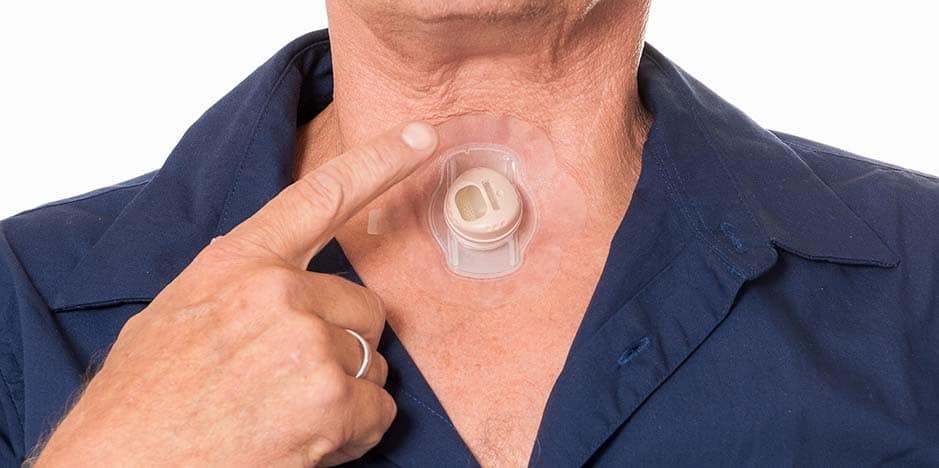Patient’s story
Find information about what you can expect before, during, and after a total laryngectomy.
Follow me
Easy access
Make sure you can always access your favourite content by connecting My Content to your email.
Connect my emailAlready connected?
If you have already connected My Content to your email all you need to do is verify your email.
Verify my emailSave your favorite content!
Found something you like? View your favorite content later by simply saving it to “My Content”.
You can easily save articles, blog posts, pages and videos to My Content by clicking the bookmark icon in connection with the content you choose.
1
Before a total laryngectomy
The right decision in a tough situation
Receiving a cancer diagnosis can come as a surprise, but an important way to deal with this shock is to be well informed. Now that you have your diagnosis the decision to undergo a laryngectomy is the next step.
Depending on the stage of the cancer, a laryngectomy is removal of part or all of the larynx (voicebox). As expected, this procedure is life-changing and will impact the way you breathe, speak, swallow, smell, and taste. But there are devices and methods to replace the sound source for your voice and live your life with fewer limitations.
01 Pre-surgery
Why undergo a total laryngectomy?
Undergoing a total laryngectomy is a lifesaving procedure especially when laryngeal cancer is advanced.
A new way to breathe
The laryngectomy surgical procedure includes the creation of an opening (stoma) in the neck which you will breathe through because there is no longer a connection between the windpipe (trachea) and the mouth and nose.
Voice and speech
Removal of the larynx (voice box) means changes to your voice and the way you speak. This loss of speech is daunting as we rely on our voices to express ourselves daily. The good news is that there are several proven ways to regain your voice.
Read moreWhat is larynx cancer?
01 Pre-surgery
Blog post: Learn how to breathe after surgery
Blog post: Learn how to breathe after surgery

You may be wondering how a laryngectomy will affect your breathing.
The procedure redirects your windpipe to the hole in your neck so you will no longer be drawing air in through your mouth and nose as you always have. Instead, the air is inhaled and exhaled through your stoma.
Your lungs will operate as normal, but breathing through an open stoma causes the temperature and humidity in your lungs to drop. The lungs react to this by producing more mucus, meaning you will have to cough more. This means you will have to protect and humidify your lungs by wearing a Heat and Moisture Exchanger (HME).
Your new nose
Heat and Moisture Exchangers (HMEs) have been developed to compensate for the lost functions of your nose. An HME sits over the opening in your neck, and they help to reduce mucus production and coughing by humidifying and filtering the air you inhale and exha
More questions?
Use the search tool to find specific information.
These resources might interest you!
Learn more about our resources.
Surgery for Laryngeal Cancer Your Total Laryngectomy Guide Voicing and Life after a Total Laryngectomy2
Surgery
What to expect before your surgery and how to prepare
After receiving the information that you will undergo surgery to remove your voice box, you may be feeling worried and uneasy. At this point, there are also many questions running through your mind. This is normal and is to be expected. The important thing to remember is why this surgery is necessary.
A good idea would be to write down all the questions you may have and take these to the hospital appointments, so you do not forget to ask the team. At this time, it is also important to speak to your family about your concerns, as well as your clinical support team as they are there to help you in any way they can.
02 Surgery
Living and breathing after a total laryngectomy
Prior to having your surgery, you may be experiencing breathing difficulties, some patients feel their breathing is improved after surgery as the tumor can block the airway.
The laryngectomy procedure will redirect your airway so that you will no longer breathe through your mouth and nose but instead you will breathe through an opening at the base of your neck called your stoma.
A common question people have about undergoing a total laryngectomy is: “Will I have to learn to breathe after my surgery?” The simple answer is no, your lungs know what to do. The air is just no longer coming in and out of your mouth and nose, instead it is entering and exiting through the stoma.
Read moreGetting ready for surgery
02 Surgery
Blog post: I am going to have a total laryngectomy
Blog post: I am going to have a total laryngectomy

Before your laryngectomy, your voice is produced by vocal cords that are located in your larynx/voice box.
Your vocal cords generate sound so you can speak.
When you breathe out, air passes through the vocal cords making them vibrate to produce sound. The sound moves into your mouth and is shaped into speech with your lips, teeth and tongue. A laryngectomy is removal of the larynx/voice box which includes the vocal cords. After surgery, your medical team can find a way to replace the sound source. Thankfully, there are several ways to do this.
There are three main options for replacing the sound source.
- Using tracheoesophageal (TE) speech using a with a voice prosthesi
- Speaking with an electrolarynx (EL)/artificial larynx
- Using esophageal speech
Download a helpful list for your appointment
Click hereTracheoesophageal speech using a voice prosthesis and esophageal speech
More questions?
Use the search tool to find specific information.
3
Hospital
What to expect during your hospital stay post-surgery
After your surgery, you will remain in the hospital while you recover from the surgery and adapt to living with a neck stoma. During this time, you will receive information and support from a dedicated health professional who will guide you through the next steps. A laryngectomy can come as a surprise and normal activities such as eating, and drinking will be difficult in the beginning. As you remain in the hospital you will slowly adapt to these changes before you head home.
03 Hospital
Taking care of your stoma
At the hospital, your dedicated health professionals will show you how to take care of the opening in your neck (stoma).
This will include a detailed demonstration of how to clean the stoma to prevent an infection, and how to change and clean your HME.
Living with a neck stoma will mean that what you viewed as simple everyday tasks will take some adjusting to. Your HCP will guide you on the best methods to brush your teeth, clear mucus, and take a shower etc.
Download packing listIn the hospital
03 Hospital
Blog post: What is an HME and why would you need to wear one?
Blog post: What is an HME and why would you need to wear one?

By now you have most certainly come across the term HME. But you may not be entirely sure what it is. Firstly, HME stands for Heat and Moisture Exchanger and this is exactly how it operates. Since you no longer have the humidifying and filtering functions of your nose, an HME can be considered your new “nose”. It will mimic the function
More questions?
Use the search tool to find specific information.
These resources might interest you!
Learn more about our resources.
What is an HME How to communicate after a total laryngectomy4
At home
What to expect on your return from the hospital
Once your time at the hospital is complete you will return home. Before leaving, you will be given material and products to help you with this transition, including a supportive app and a Coming Home kit to introduce you to the products that will help you cough less and breathe better.
You will be closely monitored while you are at home. Your speech therapist will be in close contact, and your surgeon will want you to attend a follow-up appointment at the hospital.
04 At home
The new normal
You may have concerns about caring for your stoma at home. After your surgery, the nurses will teach you how to take care of your stoma. You will also be introduced to HMEs; these products will be your “new nose”.
As you have never used an HME before your lungs may start to produce more mucus. This is normal and will settle down once your lungs have adapted to HME use. There are several types of HME’s that help you rest, sleep better, and protect your airways.
Remember this is a journey, take your time and adapt to your “new normal”. Try not to rush the process, give yourself time to adjust, and get used to breathing through your stoma.
What to expect at home
04 At home
Blog post: When to change or replace your HME
Blog post: When to change or replace your HME

At this stage, you may have had an introduction of how to use an HME at hospital. When leaving the hospital you will receive a coming home kit that will include a number of HMEs and attachments to help you grow accustomed to wearing an HME.
Your stoma lead directly to your lungs, so it is important to keep it covered with an HME. An HME must be replaced at least every 24 hours in order to maintain its effectiveness and to prevent the growth of microorganisms.
How do I know when to change an HME
HMEs are single-use devices that should be used once and always replaced at least every 24 hours. But there are times that you will need to remove and change the HME during the day. There is a range of HMEs for different situations and you will want to change your HME depending on the situation.
However there are times when you will need to change your HME to ensure you get the best performance.
Change your HME if it becomes clogged with mucus
You should change your HME if mucus gets inside and clogs the foam. It is important
More questions?
Use the search tool to find specific information.
These resources might interest you!
Learn more about our resources.
My Lilly effect Voicing and life after a total laryngectomy5
Living with a Laryngectomy
Adjusting to life with a laryngectomy
Now that you are home after your surgery, you will be adapting to a new way of breathing, speaking and living. While a laryngectomy will lead to some major changes in the way you live, it is still possible to live a happy and fulfilled life.
After your total laryngectomy, you will breathe through a stoma in your neck. You will also no longer have vocal cords. Luckily, there are Heat and Moisture Exchangers designed to function as your upper airways used to, as well as proven ways to regain your voice.
So, now is the time to get back to living life. You can continue to be active by going for walks and exercising, socializing and doing most things you enjoyed before your surgery.
05 Laryngectomy life
Living with a Laryngectomy
Undergoing a total laryngectomy brings a number of unavoidable changes that can be difficult to adjust to in the beginning.
Adjusting to your new way of living takes time and will require patience and sometimes planning. That’s why it is important to find a routine for your stoma care.
Having a total laryngectomy does not define you. You are still you. It is also beneficial to know you are not alone, allow others to help you, and reach out to support groups. You may find comfort and motivation from those that have had the same experience as you.
In this video, you will be taken through the steps to help you establish a routine and receive valuable advice to help you live well with a laryngectomy.
A Guide to Living with Laryngectomy
More questions?
Use the search tool to find specific information.
What should I pack?
Sign up to get a free checklist with information about what to pack and how to prepare before going to the hospital.
Sign up here

